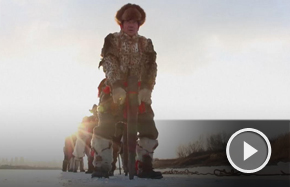Five hot spots for a northern exposure
 |
|
Heavenly Lake at Changbai Mountain takes the shape of a lotus leaf. Liu Zhaoming /for China Daily |
Changchun and its majestic surroundings will put tourists on top of the world.
For many Chinese, the city is a quiet provincial capital in China's northeast corner with a slow pace of life. But Changchun is a modern metropolis full of surprises. During the winter, keen swimmers gather around the icy lake and after a freezing dip laugh loudly. In public spaces adorned with sculptures, skateboarding teenagers, donning trendy T-shirts and wearing fashionable jeans, sing "Red songs" from Mao-era movies from the 1960s.
Mules or donkeys amble along the streets hauling carts as executives in their flashy Audi cars wait for them to pass by. The city, in Jilin province, is also known as the "Detroit of China", thanks to a busy automotive industry, which helps drives the local economy. But Changchun is also known as "Forest City" because 40 percent of its urban area is covered with trees. The green canopy serves as a cool shelter during the sweltering summer. In winter, it turns into a Norwegian-style skiing paradise. Some of China's best ski resorts are located nearby.
A visitor to Changchun cannot go wrong at any of these five places.
1. Jingyuetan National Forest Park
Changchun is a place known for its busy automotive factories but this capital city is not an industrial eyesore because of parks like this one.
This lush national park is 9 km away from the city center and boasts a total area of 96 square kilometers, making it one of the biggest man-made forest in Asia.
The park's scenic areas consist of four sections: Yuetan Waters; Tanbei Mountain; Tan'nan Forest, and Tandong Farmlands, offering tourists different charms during the different seasons.
A very pleasant way to spend an afternoon is to take a stroll in the woods through a vast forest of poplar, pine and willow trees. In winter, the park becomes a snow-covered paradise and a favorite destination for skiing, skating and watching amazing ice sculptures take shape.
2. Changbai Mountain
Changbai means "perpetually white" and is the name of this beautiful mountain located on the border of China and Democratic People's Republic of Korea.
The mountain is located 500 km west of Changchun and getting there requires a 50-minute flight to Yanjin followed by a 4-hour coach ride. Although the journey involves a decent hike, it's well worth the effort because it is truly one of the great mountain ranges in China.
The most breathtaking sight is Heavenly Lake (pictured above), which takes the interesting shape of a lotus leaf. The 13 sq km crystal clear lake is the source of Songhua and Yalu rivers.
It is highly recommended to view the lake from Tianwenfeng, the peak of Changbai Mountain.
Right below the lake is a beautiful 68-meter-long waterfall.
During the winter, the spray from the falls immediately turns into icy pearls.
The waterfall, along with the valley, underground river, forests, low hanging clouds and mist creates a magical place to escape the rat race.
3. South Lake Park
South Lake Park, first built in 1933, is located in the southwest of Changchun city. With a total area of more than 220 hectares, South Lake Park is second largest public park in China, following the Summer Palace grounds in Beijing.
It is usually seen as a landmark of the city, and a very popular destination for locals.
They stand on the arched bridges, sip tea in traditional pavilions and paddle away in hired boats through the lotus leaf-covered lakes.
In winter when the water freezes solid, visitors take part in various kinds of winter sports, such as skiing, skating and dog-sledding.
4. Changchun Film City
Adjacent to Jingyuetan National Forest Park is the must-see Changchun Film City.
Dubbed "Oriental Hollywood", many Mao-era movies were made here and the studio still plays a major role in the making of today's Chinese films.
Changchun Film City is now a theme park for tourists who can discover all the details of the filmmaking process.
The theme park was established in 1992, and includes different background scenes, such as old Beijing streets and imperial palaces.
The Changchun International Film Festival is held here every year.
 5. 'Puppet' Imperial Palace
5. 'Puppet' Imperial Palace
From 1932 to 1945, Changchun was the capital of the Japanese puppet state of Manchukuo and this historical palace is where China's last emperor Puyi lived.
Puyi was installed by the Japanese Manchukuo government as a puppet ruler in Changchun.
Together with the nearby History of the Occupation of Northeastern China Museum, the Puppet Imperial Palace is a well-preserved reminder of a time when China was far from the economic juggernaut as it is today. The architecture is a combination of both traditional Chinese and Western styles.
The large campus of stately buildings leads visitors from well-restored bedchambers to backyard gardens with Buddhist shrines.
The exhibits recreate realistic scenes of the emperor's past. Fans of courtly drama and political intrigue, and those with a penchant for dioramas are sure to have a good time.
IF YOU GO
Flights
A flight to Changchun Longjia International Airport from Beijing takes less than 2 hours and prices start from 880 yuan (96 euros), while flights from Shanghai take about 2.5 hours and cost 1,200 yuan.
Climate
Changchun has four distinctive seasons with long cold winters, short warm summers, dry windy springs, and cloudless autumns. In the summer, it can reach 40C and falls well below zero during winter.
Food
Changbai banquets are served with rare dishes made from exotic ingredients. All the ingredients come from Changbai Mountain and include ginseng, deer antler, bear's paw and snow toad.
Ginseng chicken with Maotai wine
Braised deer's tail
Steamed white fish
Souvenirs
Ginseng: Wild ginseng and the cultivated variety are two kinds found here. Wild ginseng is very expensive because it is extremely rare.
Deer horns
Woodcarvings




















